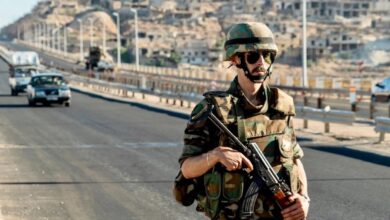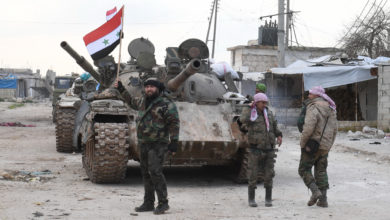Turkey and US agree to jointly administer northern Syria border zone
Deal sees safe zone becoming a "peace corridor" for Syrian refugees to return from Turkey
The U.S. and Turkey agreed to establish a joint operations center to administer a proposed buffer zone on Syria’s northeastern border, the Turkish Defense Ministry and U.S. State Department announced on Wednesday, August 7.
The two sides agreed to set up the center in Turkey “as soon as possible in order to coordinate and manage the establishment of the safe zone together,” the U.S. Embassy in Turkey announcement read.
The announcement came on the third day of military negotiations between the two sides in Ankara. The Washington Post reported Sunday that the U.S. was prepared to offer joint U.S.-Turkish patrols in a zone about 15 kilometers deep as a last resort.
The two sides have been in negotiations since early this year over the size of the proposed zone and whose forces will administer it.
Turkey had previously demanded a 30-kilometer zone overseen by the Turkish military, which would include nearly all Kurdish-majority areas in Syria. The U.S.-backed SDF rejected that offer, proposing an internationally-controlled five-kilometer zone that the YPG agreed to evacuate, the SDF’s top commander Mazlum Abdi said last week.
The Turkish government has been threatening for months to launch a unilateral incursion into northern Syria to clear the border area of the U.S.-backed People’s Protection Units (YPG) militia, unseat affiliated political figures and resettle Syrian refugees currently living in Turkey there.
Turkey has launched two previous incursions into northern Syria, taking control of much of Idlib province with Operation Euphrates Shield in 2016 and the mainly Kurdish enclave of Efrin with Operation Olive Branch in January 2018, which led to mass civilian displacement.
Erdogan has said that some 300,000 Syrian refugees have been returned to parts of Syria under Turkish military control. The United Nations has accused Turkey-backed rebels in Efrin of war crimes.
Wednesday’s agreement makes no mention of the size of the border zone, nor of SDF or YPG presence in the area, but acknowledges the Turkish government’s concern to return Syrian refugees.
The U.S. Embassy in Turkey said the “safe zone shall become a peace corridor, and every effort shall be made so that displaced Syrians can return to their country.”
“It’s a slow walk toward a U.S.-chaperoned effort to give Erdogan a ‘win,’ while protecting the SDF,” said Nicholas Heras, a fellow at the Center for New American Security.
Turkey considers the Kurdish-led YPG to be the Syrian branch of the Kurdistan Workers’ Party, or PKK, a Kurdish nationalist guerilla group founded in Turkey that Ankara and its Western allies have designated a terrorist organization.
A significant number of U.S. Special Operations Forces, alongside some British and French troops, remain in Syria’s northeast, where they have trained and advised the YPG-led Syrian Democratic Forces in the ground war against Islamic State.
In December, U.S. President Donald Trump announced all American forces would withdraw from Syria just days after speaking to Erdogan by phone, sending American officials scrambling to buy time from the president in order to negotiate a deal to preserve the SDF.
Erdogan and Trump discussed setting up a safe zone along the border in January, and in February the American president reportedly approved a residual force of several hundred U.S. forces in Syria.
The U.S. and Turkey previously agreed in June 2018 to conduct joint patrols around the SDF-controlled northern Syrian city of Manbij and facilitate YPG evacuation from the area. Turkey has long accused Washington of stalling on that agreement.
The U.S. assured the Turkish government years ago that its partnership with the YPG and SDF was temporary and that weapons provided to the group would be collected upon the defeat of ISIS.
The SDF captured the last remaining ISIS-held territory in Syria in March with international Coalition support.
But the U.S. continues to supply the SDF as it transitions towards internal security. Washington estimates thousands of ISIS sleeper cells remain across Syria and Iraq, and the SDF is guarding tens of thousands of ISIS prisoners and their families captured in the war at makeshift camps.
SDF officials have repeatedly warned that they will divert forces to defend against any Turkish incursion and may not be able to contain the ISIS prisoners.
Defense Secretary Mark Esper said Tuesday that the U.S. intends to “prevent” any unilateral Turkish incursion and would find such action “unacceptable,” but did not explicitly say the U.S. intends to defend the SDF.
The Washington Post reported Sunday that American officials have “made clear” that the U.S. military is not authorized by Congress to defend their “Kurdish partners” from a Turkish attack.
The Congressional authorization for U.S. operations against ISIS in Iraq and Syria is based on the 2001 Authorization of the Use of Military Force, which has been interpreted to apply only to Sunni jihadist groups such as Al-Qaeda and ISIS.
But the U.S. has struck Syrian regime forces and even Russian military contractors encroaching on Coalition-held territory in Syria, citing self-defense and defense of the SDF.
Following Trump’s announcement in December, a State Department official instructed CJTF-OIR commander Lieutenant General Paul LaCamera to abandon Coalition outposts along the Syrian side of the Turkish border so as not to falsely signal to Turkey that the U.S. intends to defend the SDF.
The Coalition has since expanded its presence near the border.











